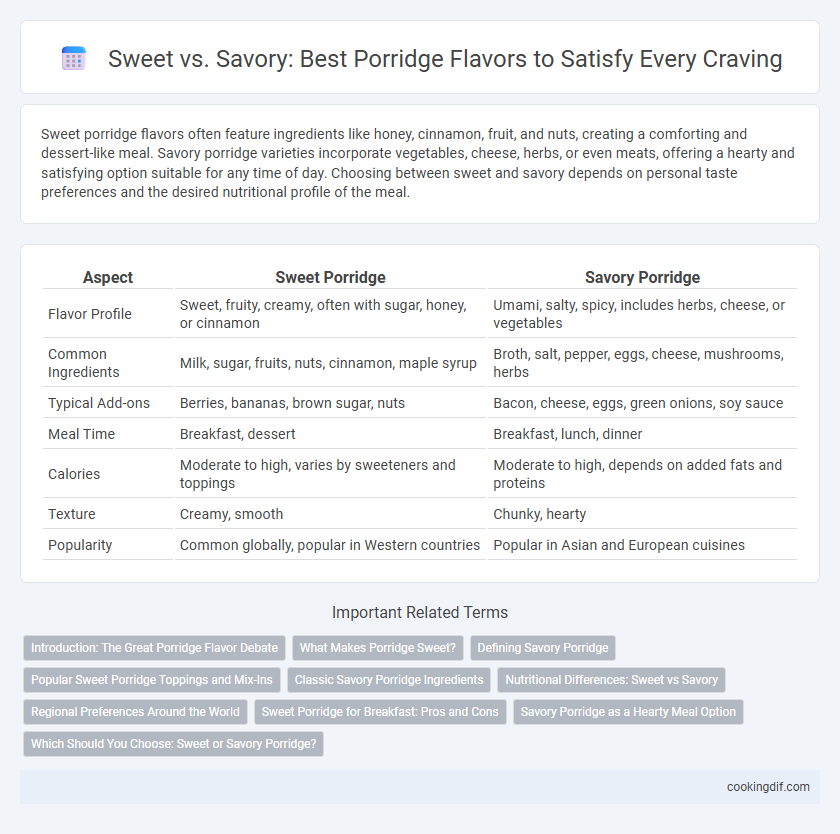Sweet porridge flavors often feature ingredients like honey, cinnamon, fruit, and nuts, creating a comforting and dessert-like meal. Savory porridge varieties incorporate vegetables, cheese, herbs, or even meats, offering a hearty and satisfying option suitable for any time of day. Choosing between sweet and savory depends on personal taste preferences and the desired nutritional profile of the meal.
Table of Comparison
| Aspect | Sweet Porridge | Savory Porridge |
|---|---|---|
| Flavor Profile | Sweet, fruity, creamy, often with sugar, honey, or cinnamon | Umami, salty, spicy, includes herbs, cheese, or vegetables |
| Common Ingredients | Milk, sugar, fruits, nuts, cinnamon, maple syrup | Broth, salt, pepper, eggs, cheese, mushrooms, herbs |
| Typical Add-ons | Berries, bananas, brown sugar, nuts | Bacon, cheese, eggs, green onions, soy sauce |
| Meal Time | Breakfast, dessert | Breakfast, lunch, dinner |
| Calories | Moderate to high, varies by sweeteners and toppings | Moderate to high, depends on added fats and proteins |
| Texture | Creamy, smooth | Chunky, hearty |
| Popularity | Common globally, popular in Western countries | Popular in Asian and European cuisines |
Introduction: The Great Porridge Flavor Debate
Sweet porridge flavors often feature ingredients like honey, cinnamon, berries, and maple syrup, offering a comforting and energizing breakfast choice rich in natural sugars and antioxidants. Savory porridge incorporates toppings such as cheese, herbs, eggs, and vegetables, providing a protein-packed, hearty meal suitable for any time of day. The ongoing debate between sweet and savory porridge centers on personal taste preferences, nutritional goals, and cultural influences shaping how this versatile dish is enjoyed worldwide.
What Makes Porridge Sweet?
Porridge becomes sweet primarily through the addition of natural sugars like honey, maple syrup, or fresh fruits such as bananas and berries, which introduce fructose and glucose that enhance its flavor profile. Sweet porridge often incorporates spices like cinnamon or vanilla extract, which amplify the perception of sweetness without adding extra sugar. The choice of milk or plant-based alternatives, such as almond or oat milk, can also contribute to the natural sweetness, distinguishing it from savory versions flavored with salt, herbs, or cheese.
Defining Savory Porridge
Savory porridge features a blend of herbs, spices, and ingredients such as cheese, vegetables, or meats, creating a rich, umami flavor profile that contrasts with traditional sweet versions. This style often incorporates broths or stocks instead of water or milk, enhancing depth and warmth in the dish. Savory porridge offers a versatile base for nutritious meals, catering to those seeking hearty and satisfying breakfast or comfort food options.
Popular Sweet Porridge Toppings and Mix-Ins
Popular sweet porridge toppings include honey, fresh berries, sliced bananas, and cinnamon, which enhance natural flavors and add antioxidants and vitamins. Mix-ins like vanilla extract, brown sugar, and nut butters provide a creamy texture and rich taste, boosting both flavor and nutritional value. Chopped nuts and dried fruits offer a satisfying crunch and additional fiber, making sweet porridge a nutritious and delicious breakfast option.
Classic Savory Porridge Ingredients
Classic savory porridge ingredients include ingredients like garlic, ginger, scallions, soy sauce, and chicken or vegetable broth, creating a rich and umami-flavored base. Proteins such as shredded chicken, minced pork, or century eggs add depth and texture, while toppings like fried shallots, cilantro, and chili oil enhance complexity and warmth. This savory combination balances hearty flavors and aromatic spices, making it a comforting and nutritious meal option.
Nutritional Differences: Sweet vs Savory
Sweet porridge varieties often contain higher sugar content, which increases caloric intake and can impact blood glucose levels, while savory porridge typically offers more protein and fiber due to ingredients like vegetables, herbs, and sometimes meat. The inclusion of nuts and seeds in sweet porridge boosts healthy fats and micronutrients, whereas savory options provide vitamins and minerals from vegetables, contributing to balanced micronutrient profiles. Choosing between sweet and savory porridge depends on dietary goals, such as managing sugar intake or seeking higher protein and fiber for sustained energy.
Regional Preferences Around the World
Sweet porridge flavors dominate in Northern Europe, with ingredients like cinnamon, honey, and berries highlighting Scandinavian and British breakfast traditions. In contrast, savory porridge is preferred in East Asian countries such as China and Korea, where it often incorporates soy sauce, scallions, and fermented vegetables for a flavorful, umami-rich experience. African regions, particularly West Africa, exhibit a balanced approach with porridge served both sweetened with palm oil and sugar or savory with spices and vegetables, reflecting diverse culinary influences.
Sweet Porridge for Breakfast: Pros and Cons
Sweet porridge for breakfast offers a quick energy boost through natural sugars from fruit or honey, enhancing flavor and making it more appealing to children. Its high sugar content can cause rapid blood sugar spikes, potentially leading to energy crashes and increased cravings later in the morning. Incorporating fiber-rich toppings like berries or nuts can balance sweetness and improve satiety, promoting a more nutritious start to the day.
Savory Porridge as a Hearty Meal Option
Savory porridge offers a hearty meal option rich in protein and nutrients, often featuring ingredients like vegetables, eggs, cheese, or meats such as bacon and sausage for sustained energy. Unlike sweet porridge, which typically includes sugars, fruits, and honey, savory porridges emphasize umami flavors and are commonly prepared with broths or spices like garlic, turmeric, and pepper to enhance taste and satiety. This versatile dish suits breakfast, lunch, or dinner, providing a balanced and satisfying alternative to traditional sweet porridge varieties.
Which Should You Choose: Sweet or Savory Porridge?
Sweet porridge typically incorporates ingredients like honey, fruit, and cinnamon, providing a comforting, energy-boosting breakfast rich in antioxidants and natural sugars. Savory porridge, on the other hand, features toppings such as cheese, herbs, or eggs, offering a protein-packed, nutrient-dense option often preferred for balanced meals throughout the day. Choosing between sweet and savory porridge depends on your dietary goals, flavor preferences, and the nutritional profile you need to complement your lifestyle.
Sweet vs Savory for porridge flavor Infographic

 cookingdif.com
cookingdif.com